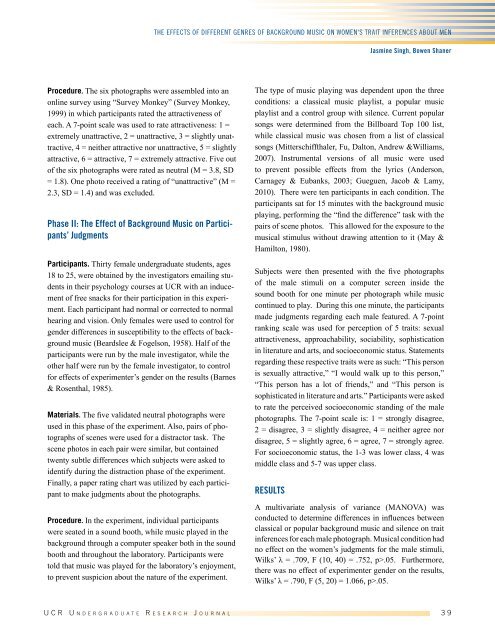Undergraduate Research Journal
Undergraduate Research Journal
Undergraduate Research Journal
You also want an ePaper? Increase the reach of your titles
YUMPU automatically turns print PDFs into web optimized ePapers that Google loves.
The Effects of Different Genres of Background Music on Women's Trait Inferences About Men<br />
Jasmine Singh, Bowen Shaner<br />
Procedure. The six photographs were assembled into an<br />
online survey using “Survey Monkey” (Survey Monkey,<br />
1999) in which participants rated the attractiveness of<br />
each. A 7-point scale was used to rate attractiveness: 1 =<br />
extremely unattractive, 2 = unattractive, 3 = slightly unattractive,<br />
4 = neither attractive nor unattractive, 5 = slightly<br />
attractive, 6 = attractive, 7 = extremely attractive. Five out<br />
of the six photographs were rated as neutral (M = 3.8, SD<br />
= 1.8). One photo received a rating of “unattractive” (M =<br />
2.3, SD = 1.4) and was excluded.<br />
Phase II: The Effect of Background Music on Participants’<br />
Judgments<br />
Participants. Thirty female undergraduate students, ages<br />
18 to 25, were obtained by the investigators emailing students<br />
in their psychology courses at UCR with an inducement<br />
of free snacks for their participation in this experiment.<br />
Each participant had normal or corrected to normal<br />
hearing and vision. Only females were used to control for<br />
gender differences in susceptibility to the effects of background<br />
music (Beardslee & Fogelson, 1958). Half of the<br />
participants were run by the male investigator, while the<br />
other half were run by the female investigator, to control<br />
for effects of experimenter’s gender on the results (Barnes<br />
& Rosenthal, 1985).<br />
Materials. The five validated neutral photographs were<br />
used in this phase of the experiment. Also, pairs of photographs<br />
of scenes were used for a distractor task. The<br />
scene photos in each pair were similar, but contained<br />
twenty subtle differences which subjects were asked to<br />
identify during the distraction phase of the experiment.<br />
Finally, a paper rating chart was utilized by each participant<br />
to make judgments about the photographs.<br />
Procedure. In the experiment, individual participants<br />
were seated in a sound booth, while music played in the<br />
background through a computer speaker both in the sound<br />
booth and throughout the laboratory. Participants were<br />
told that music was played for the laboratory’s enjoyment,<br />
to prevent suspicion about the nature of the experiment.<br />
The type of music playing was dependent upon the three<br />
conditions: a classical music playlist, a popular music<br />
playlist and a control group with silence. Current popular<br />
songs were determined from the Billboard Top 100 list,<br />
while classical music was chosen from a list of classical<br />
songs (Mitterschiffthaler, Fu, Dalton, Andrew &Williams,<br />
2007). Instrumental versions of all music were used<br />
to prevent possible effects from the lyrics (Anderson,<br />
Carnagey & Eubanks, 2003; Gueguen, Jacob & Lamy,<br />
2010). There were ten participants in each condition. The<br />
participants sat for 15 minutes with the background music<br />
playing, performing the “find the difference” task with the<br />
pairs of scene photos. This allowed for the exposure to the<br />
musical stimulus without drawing attention to it (May &<br />
Hamilton, 1980).<br />
Subjects were then presented with the five photographs<br />
of the male stimuli on a computer screen inside the<br />
sound booth for one minute per photograph while music<br />
continued to play. During this one minute, the participants<br />
made judgments regarding each male featured. A 7-point<br />
ranking scale was used for perception of 5 traits: sexual<br />
attractiveness, approachability, sociability, sophistication<br />
in literature and arts, and socioeconomic status. Statements<br />
regarding these respective traits were as such: “This person<br />
is sexually attractive,” “I would walk up to this person,”<br />
“This person has a lot of friends,” and “This person is<br />
sophisticated in literature and arts.” Participants were asked<br />
to rate the perceived socioeconomic standing of the male<br />
photographs. The 7-point scale is: 1 = strongly disagree,<br />
2 = disagree, 3 = slightly disagree, 4 = neither agree nor<br />
disagree, 5 = slightly agree, 6 = agree, 7 = strongly agree.<br />
For socioeconomic status, the 1-3 was lower class, 4 was<br />
middle class and 5-7 was upper class.<br />
Results<br />
A multivariate analysis of variance (MANOVA) was<br />
conducted to determine differences in influences between<br />
classical or popular background music and silence on trait<br />
inferences for each male photograph. Musical condition had<br />
no effect on the women’s judgments for the male stimuli,<br />
Wilks’ λ = .709, F (10, 40) = .752, p>.05. Furthermore,<br />
there was no effect of experimenter gender on the results,<br />
Wilks’ λ = .790, F (5, 20) = 1.066, p>.05.<br />
U C R U n d e r g r a d u a t e R e s e a r c h J o u r n a l 3 9














